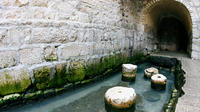Guided Tour of Jerusalem: The Biblical City of David
Jerusalem, Israel
Rating: 









Trip Type: City Tours
Duration: 3 hours
Come join in on a three hour adventure as we rediscover Ancient Jerusalem. Jerusalem was born over three thousand years ago on a small hilltop called the City of David. Today, countless archaeological excavations are continually revealing incredible discoveries that are changing our understanding of Jerusalem’s history throughout the ages. The stones are revealing their secrets, and the City of David's expert guides are excited to share them with you.
More About This Activity All City Tours →
Come join in on a three hour adventure as we rediscover Ancient Jerusalem. Jerusalem was born over three thousand years ago on a small hilltop called the City of David. Today, countless archaeological excavations are continually revealing incredible discoveries that are changing our understanding of Jerusalem’s history throughout the ages. The stones are revealing their secrets, and the City of David's expert guides are excited to share them with you.While the modern city of Jerusalem bustles with life above ground, below ground, the ancient city of Jerusalem is being rediscovered, one pickaxe at a time. The City of David, located outside the Old City Walls actually predates the Old City by hundreds of years. Measuring only 11 acres, Jerusalem’s birthplace is unsurprisingly one of the most extensively excavated sites in the region.
The tour of the City of David begins with a breathtaking observation point overlooking Biblical Jerusalem which sends visitors 3,800 years back in time to the days of Abraham, when the first foundations of the city were laid.
The journey continues to an excavation that might very well be the site of King David’s Palace. Archaeological excavations revealed foundation stones from the 10th century BC, the period when King David lived and ruled. Bullae, clay seal impressions bearing Hebrew names from the Bible were found, as well as a tower that was part of the city walls during the days of Nehemiah, who lived during the Second Temple period.
Stop at the Royal Acropolis, also known as Area G, to see First Temple homes which were destroyed in the destruction of Jerusalem, before descending underground into the water system, with which the city was originally conquered by David and his men. Pass through the Gihon Spring Citadel, which protected Jerusalem’s main water source- the Gihon Spring, before entering the highlight of our tour-a walk through Hezekiah’s Tunnel . The Spring’s waters still flow through the tunnel, making for a fun and wet adventure. An alternative, dry route is open to those who choose.
Up next is the famous Siloam Pool, and the Herodian Road and Water Channel. Visitors who choose may finish their tour at the Siloam Pool and take a shuttle (for a small fee) up to main entrance. The Herodian Road was the main thoroughfare of Jerusalem during the Second Temple Period. Abutting the road is a water drainage tunnel that collected rainwater and brought it outside of the city. It also served a s a refuge for Jews who were trying to escape the Romans. An incredible amount of important and rare artifacts were found in this tunnel and channel that have greatly contributed to our understanding of events. The tour concludes in the Givati Parking Lot Excavation, the largest archaeological excavation in the region, which is continually revealing new layers of Jerusalem’s history, from the Biblical to the Islamic period.
The tour of the City of David begins with a breathtaking observation point overlooking Biblical Jerusalem which sends visitors 3,800 years back in time to the days of Abraham, when the first foundations of the city were laid.
The journey continues to an excavation that might very well be the site of King David’s Palace. Archaeological excavations revealed foundation stones from the 10th century BC, the period when King David lived and ruled. Bullae, clay seal impressions bearing Hebrew names from the Bible were found, as well as a tower that was part of the city walls during the days of Nehemiah, who lived during the Second Temple period.
Stop at the Royal Acropolis, also known as Area G, to see First Temple homes which were destroyed in the destruction of Jerusalem, before descending underground into the water system, with which the city was originally conquered by David and his men. Pass through the Gihon Spring Citadel, which protected Jerusalem’s main water source- the Gihon Spring, before entering the highlight of our tour-a walk through Hezekiah’s Tunnel . The Spring’s waters still flow through the tunnel, making for a fun and wet adventure. An alternative, dry route is open to those who choose.
Up next is the famous Siloam Pool, and the Herodian Road and Water Channel. Visitors who choose may finish their tour at the Siloam Pool and take a shuttle (for a small fee) up to main entrance. The Herodian Road was the main thoroughfare of Jerusalem during the Second Temple Period. Abutting the road is a water drainage tunnel that collected rainwater and brought it outside of the city. It also served a s a refuge for Jews who were trying to escape the Romans. An incredible amount of important and rare artifacts were found in this tunnel and channel that have greatly contributed to our understanding of events. The tour concludes in the Givati Parking Lot Excavation, the largest archaeological excavation in the region, which is continually revealing new layers of Jerusalem’s history, from the Biblical to the Islamic period.
« Go Back

